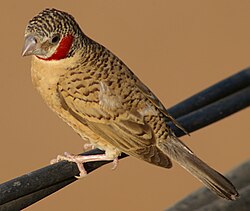| Cut-throat finch | |
|---|---|
 | |
| Male | |
 | |
| Female | |
| Scientific classification | |
| Kingdom: | Animalia |
| Phylum: | Chordata |
| Class: | Aves |
| Order: | Passeriformes |
| Family: | Estrildidae |
| Genus: | Amadina |
| Species: | A. fasciata |
| Binomial name | |
| Amadina fasciata (Gmelin, JF, 1789) | |
The cut-throat finch (Amadina fasciata) is a common species of estrildid finch found throughout Africa; it is also known as the bearded finch, the ribbon finch, the cut throat, and the weaver finch.


